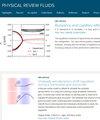Equatorial blowup and polar caps in drop electrohydrodynamics
IF 2.5
3区 物理与天体物理
Q2 PHYSICS, FLUIDS & PLASMAS
引用次数: 0
Abstract
We illuminate effects of surface-charge convection intrinsic to leaky-dielectric electrohydrodynamics by analyzing the symmetric steady state of a circular drop in an external field at arbitrary electric Reynolds number . In formulating the problem, we identify an exact factorization that reduces the number of dimensionless parameters from four— and the conductivity, permittivity and viscosity ratios—to two: a modified electric Reynolds number and a charging parameter . In the case , where charge relaxation in the drop phase is slower than in the suspending phase, and, as a consequence, the interface polarizes antiparallel to the external field, we find that above a critical value the solution exhibits a blowup singularity such that the surface-charge density diverges antisymmetrically with the power of distance from the equator. We use local analysis to uncover the structure of that blowup singularity, wherein surface charges are convected by a locally induced flow towards the equator where they annihilate. To study the blowup regime, we devise a numerical scheme encoding that local structure where the blowup prefactor is determined by a global charging-annihilation balance. We also employ asymptotic analysis to construct a universal problem governing the blowup solutions in the regime , far beyond the blowup threshold. In the case , where charge relaxation is faster in the drop phase and the interface polarizes parallel to the external field, we numerically observe and asymptotically characterize the formation at large of stagnant, perfectly conducting surface-charge caps about the drop poles. The cap size grows and the cap voltage decreases monotonically with increasing conductivity or decreasing permittivity of the drop phase relative to the suspending phase. The flow in this scenario is nonlinearly driven by electrical shear stresses at the complement of the caps. In both polarization scenarios, the flow at large scales linearly with the magnitude of the external field, contrasting the familiar quadratic scaling under weak fields.

水滴电动流体力学中的赤道吹胀和极冠
我们通过分析任意电雷诺数 ReE 条件下圆形液滴在外场中的对称稳态,阐明了漏介质电动流体力学固有的表面电荷对流效应。在ϖ<0的情况下,液滴相中的电荷弛豫比悬浮相中的慢,因此界面极化与外场反平行,我们发现在临界 Rẽ值以上,溶液表现出炸裂奇异性,表面电荷密度随距赤道距离的-1/3次方反对称发散。我们利用局部分析揭示了炸裂奇点的结构,即表面电荷被局部诱导流对流向赤道,并在那里湮灭。为了研究炸毁机制,我们设计了一种数值方案,对局部结构进行编码,其中炸毁前因子由全局电荷-湮灭平衡决定。我们还采用渐近分析法,构建了一个普遍问题,用以控制远超过炸毁阈值的 Rẽ≫1 制度中的炸毁解。在ϖ>0的情况下,电荷弛豫在液滴阶段更快,界面极化平行于外部磁场,我们数值观察到在大Rẽ时,液滴两极周围会形成停滞的、完全导电的表面电荷帽,并对其进行了渐近表征。随着液滴相相对于悬浮相的电导率增大或介电常数减小,电帽尺寸增大,电帽电压单调降低。这种情况下的流动是由电帽互补处的电剪应力非线性驱动的。在这两种极化情况下,大 Rẽ 时的流动与外部磁场的大小成线性比例,这与我们熟悉的弱磁场下的二次方比例形成鲜明对比。
本文章由计算机程序翻译,如有差异,请以英文原文为准。
求助全文
约1分钟内获得全文
求助全文
来源期刊

Physical Review Fluids
Chemical Engineering-Fluid Flow and Transfer Processes
CiteScore
5.10
自引率
11.10%
发文量
488
期刊介绍:
Physical Review Fluids is APS’s newest online-only journal dedicated to publishing innovative research that will significantly advance the fundamental understanding of fluid dynamics. Physical Review Fluids expands the scope of the APS journals to include additional areas of fluid dynamics research, complements the existing Physical Review collection, and maintains the same quality and reputation that authors and subscribers expect from APS. The journal is published with the endorsement of the APS Division of Fluid Dynamics.
 求助内容:
求助内容: 应助结果提醒方式:
应助结果提醒方式:


